Medtronic recently announced that they’re discontinuing their 1.8 mL insulin pump reservoirs, leaving only their 3 mL reservoirs. The 1.8 mL reservoir will not be available through NDSS after the 30th of June 2023.
History
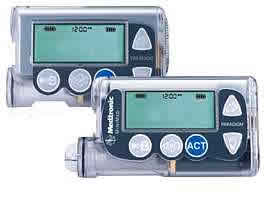 With the Paradigm family of pumps Medtronic usually had two versions of each model. For example the 522 and 722 are identical in functionality. But the 722 is a bit longer, and can take both sizes of reservoir. The 522 is more compact, but can only use the 1.8 mL reservoir.
With the Paradigm family of pumps Medtronic usually had two versions of each model. For example the 522 and 722 are identical in functionality. But the 722 is a bit longer, and can take both sizes of reservoir. The 522 is more compact, but can only use the 1.8 mL reservoir.
I saw a 1.8 mL version of the 640G pump, but by the time they took it to the market they had decided to make them all 3 mL-capable pumps. Ever since, every new Medtronic pump has been able to use both the 180U and 300U reservoirs.
Finally they’re pulling the pin on the 1.8 mL size.
Impact
Many people use the 1.8 mL reservoirs in the current (large) Medtronic pumps. They find that 180U is enough to last them. But they won’t be impacted by this: they can use the 3 mL reservoirs (which cost the same) and just fill them with the same amount of insulin they were using before. There’s nothing that says you have to completely fill the reservoir.
I must admit that when I used a pump with a reservoir that big I would fill it, then gradually run it down till almost empty (using a new infusion set every 3 days of course, but not needing a fresh reservoir at each site change).
The people who will be affected by the change are those who are using the older 512, 515, 522, and Veo 554 pumps. These are still used today by many people who are running opensource A.I.D. software such as OpenAPS, Loop (iPhone), iAPS (iPhone), and AndroidAPS (Android). “DIY loopers” is one name for that community.
Obviously without reservoirs these 5xx pumps may become paperweights, but the world isn’t actually that black and white. There seem to be a few options:
| Stock up | There’s a month left to order reservoirs, so people may be able to stock up a bit. Obviously that’s not a long-term solution, but it does at least give some breathing space. |
| Upgrade to a 7xx | The 712, 715, 722, and 754 pumps will not be affected by the change.
Note that the 754 needs to have firmware of 2.7A or below to be compatible with OS-AID. All versions of the 715 and 722 work fine. |
| Switch to a different pump | Those OS-AID systems do support a few other pump models, including the Omnipod DASH. The DANA-i and Accu-Chek Combo pumps are also supported on the Android systems. Those are the current OS-AID alternatives in Australia.
Some of the Paradigm loopers might end up moving to one of the commercial AID systems such as CamAPS FX (which comes with the YpsoPump). |
| Find replacement reservoirs | Some of the patents on these old reservoirs have expired, but even so there aren’t really any third-party options available in Australia. But I’ll discuss a related option below. |
Stocking up
Keep in mind that NDSS has a default quota of 90 reservoirs (i.e. 9 boxes) within the last 180 days. That’s reservoirs of all models.
We can look in the My NDSS portal to see when we ordered them over the last 6 months, and work out how many more can be ordered before the end of June.
Also keep in mind that NDSS generally don’t allow us to order more than two boxes at once. But depending on how many reservoirs have been ordered recently, there should hopefully be enough time in the remaining 4 weeks to build up a bit of a buffer. Hopefully supply doesn’t dry up early.
Emergency backup: Converting 3 mL reservoirs
I had to do this once when I was away from home, using a Medtronic 554 but not able to find new 1.8 mL reservoirs. I had already re-used my last reservoir once, but wasn’t prepared to keep doing that.
Of course it’s important to note that:
This is entirely off-label and not supported by anyone!
Basically, the only difference between the two versions of Medtronic reservoir is the length.
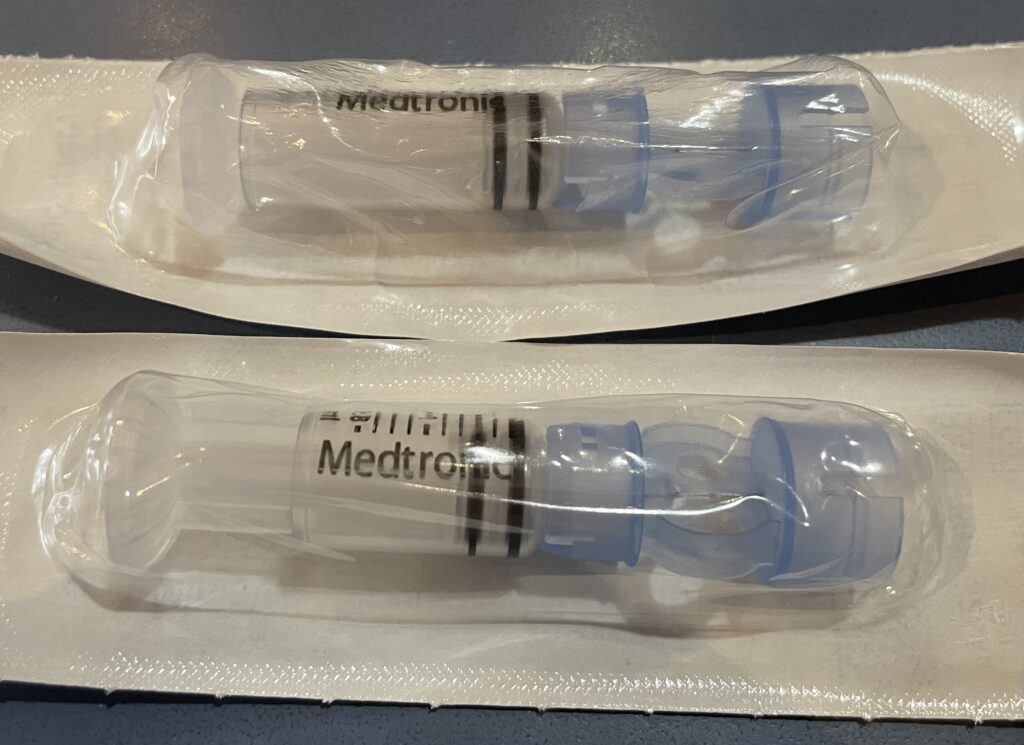
So what if we cut off the extra plastic? This is what I did, with a sharp craft knife. In fact with a fresh (both sharp and clean) blade.

As you can see here, I’ve drawn the plunger back to the 1.8 mL position (see the top black ring – to the left in this photo). And then unscrewed the handle. By doing this I was able to see where to make the cut (just to the right [“below”] of the plunger). The plunger also provides some structural support to keep the reservoir cylindrical while cutting.
I wanted to do the cutting as quickly and as neatly as possible, without introducing dust/etc to the reservoir that I was about to fill with insulin!
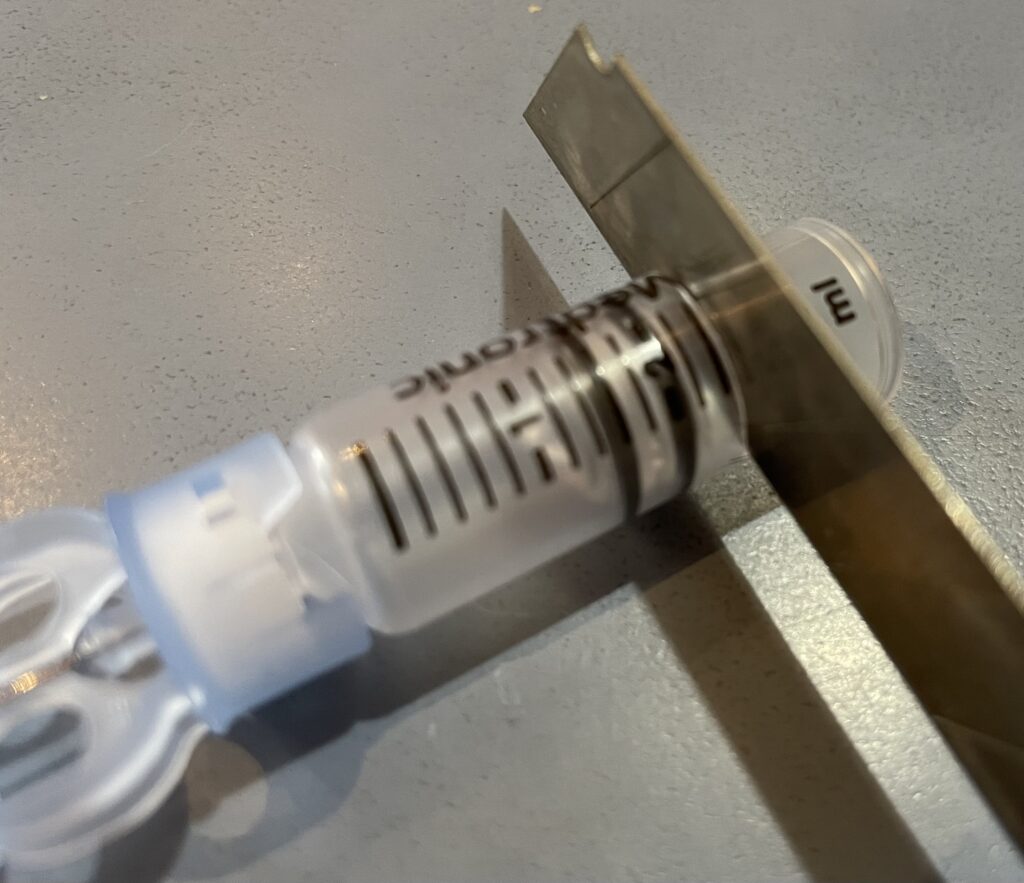
If we deform the reservoir too much, we conceivably might compromise the seal of those black rubber rings, allowing insulin to leak out. When I did this procedure I made the blade as long as I could and used a forceful sawing motion so the continual movement of the blade did more of the cutting than simply pressing down. It didn’t take long to cut through the plastic.
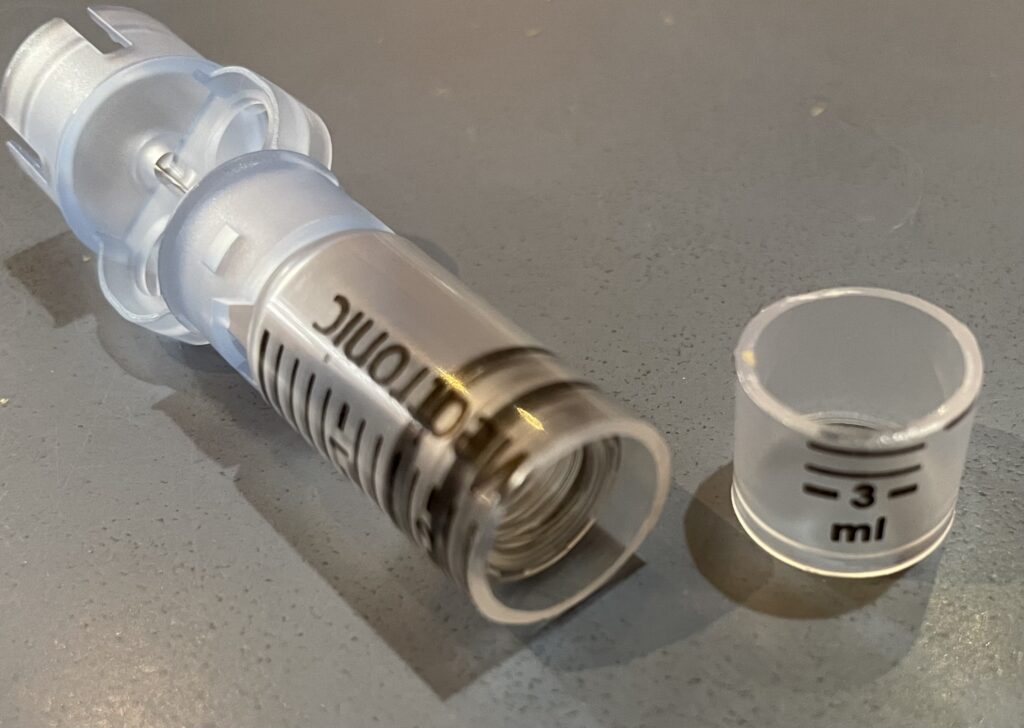
As it got to the end I was careful to rotate the tubing and avoid leaving a “dag” of plastic hanging down making the tubing longer than it should be. It needs to fit into the smaller pump.
Having shortened the reservoir I then screwed the handle back in and proceeded to fill it with insulin as per normal.
Lack of a “lip”
As you can see in the above photo (below the “3 ml” mark) the original reservoir has a ridge or “lip” just before the end of the reservoir. This can help us avoid pulling the plunger too far when drawing up insulin, which would ruin the sterility of the reservoir as well as leave us with a lap full of insulin. A similar trap has caught some newcomers to the YpsoPump.
It’s not a problem as long as I remember to not draw the plunger too far.
It works
No-one’s going to guarantee it, but the shortened reservoirs worked very well for me. I only ever converted them immediately before filling and using them, as otherwise I would have no way of keeping them sterile in the meantime. This did mean that I needed to have a sharp blade with me, which would complicate some travel scenarios.
But they worked fine.
Much better to have actual 1.8 mL reservoirs of course! Especially while travelling.

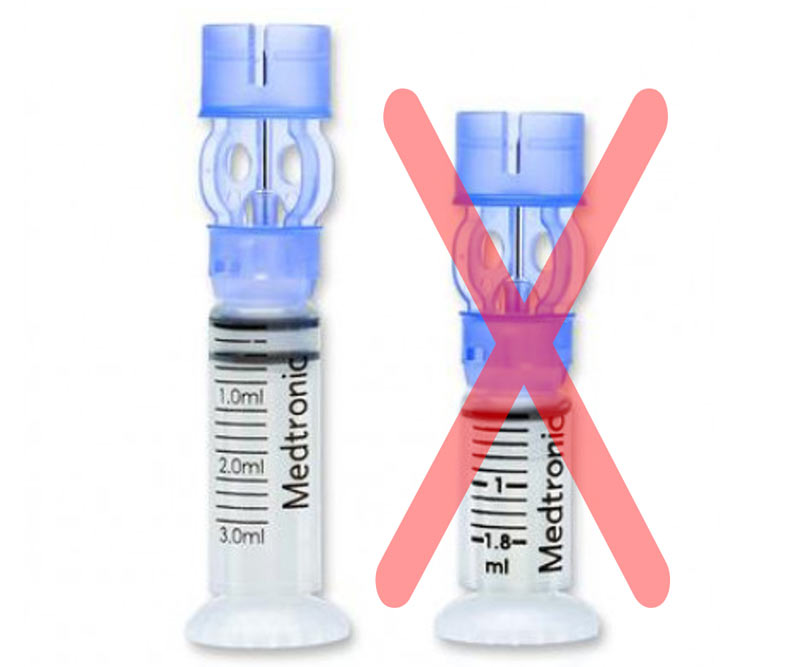

Sad news, I am using iAPS with my trusty 522, and I love the combo. However I was prepared to try the cutting anyways as soon Medtronic released their 7 day infusion set, which I’ve heard only comes with 3ml reservoirs in places where it has already been released. It is not released in Canada yet. I found a little plastic jig design on thingiverse to help aid in making a straight cut in the 3ml reservoirs. I got my son to print this jig with the 3D printers at his school. I haven’t tried it yet so can’t testify to its efficacy, but if you Google search it In sure you’ll find it and maybe you can test it. If it works well maybe you want to link it to your blog post.
That would be this 3D design I presume.
When having to do the conversion I obviously didn’t have a 3D printer in my backpack. 🙂
Hi David, Thanks for the heads up. That news does indeed effect me (using the 522).
I’ve also see 3D-printed jig devices one can obtain, for positioning the 3mL reservoirs to be cut down to the correct size, but it’s nice to see a way of carefully doing that without needing such a device. Still, needing to hand-saw every reservoir I need to use in the future, does seem like a lot — on top of the usual diabetic hassles. I’m sure I could switch to different loop-able pump option that insurance would cover. I guess I should start thinking long-term about which other (loop-able) pump I’d like best.
Also: this morning I played the first half of your interview on Juicebox. Nice to hear you explaining your past and current approaches to DIY looping.
I’m using what they now call iAPS, and (although I think I probably have all the settings and tools I need) I am still a long ways off from any “no bolus” UAM lifestyle.
Looking forward to playing the rest of your (Juicebox) interview!
It looks to me like a cigar cutter should do the job as well.